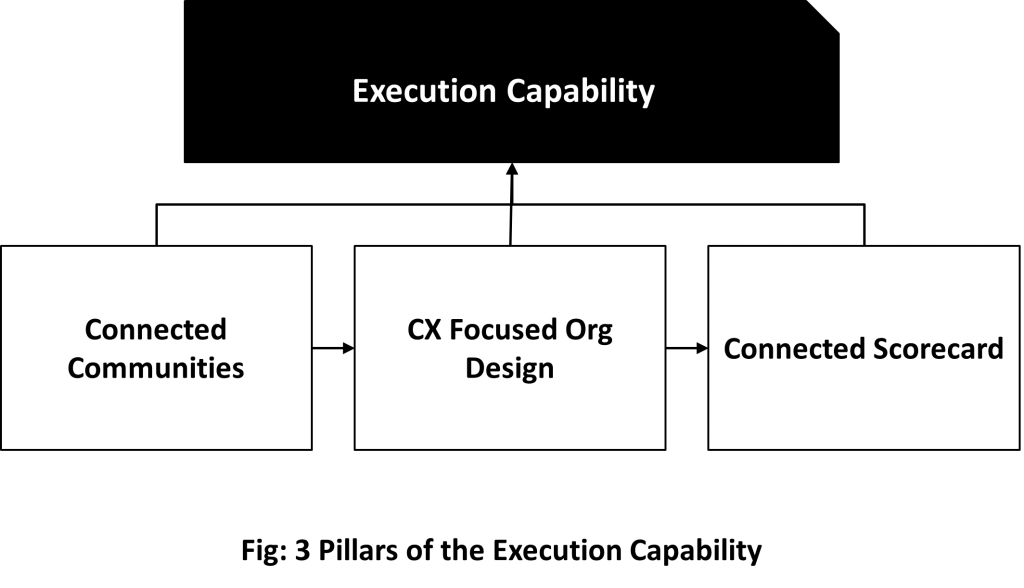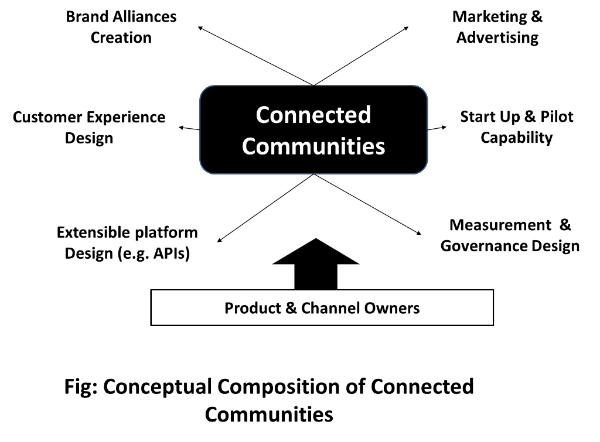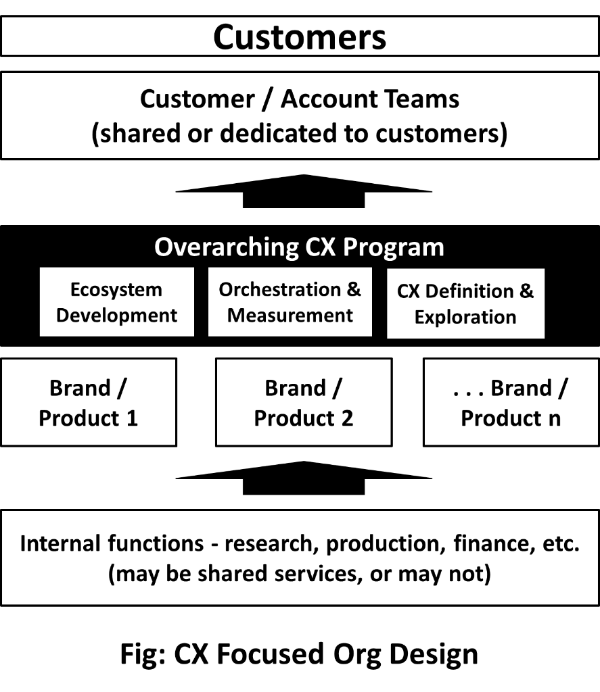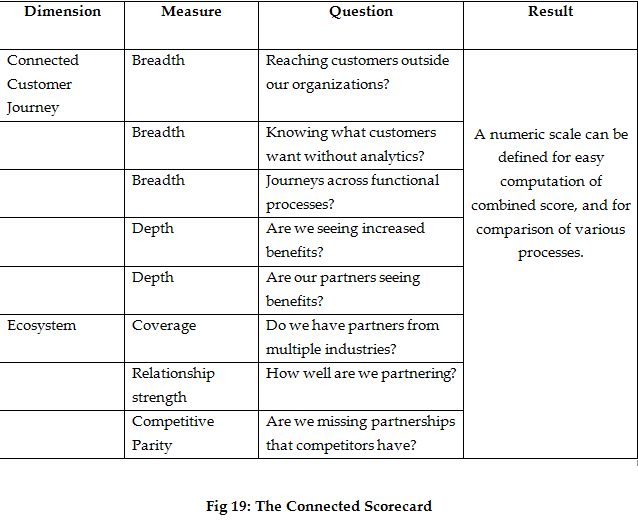After reading the first few chapters of my book, let’s say you’re gung-ho on cross industry collaboration. Here I’ll outline the chapter on how we can gear up to actually execute on our connected vision.
I’ll address the concepts of:
- Connected Communities,
- CX focused org design,
- Connected Scorecard
These three topics will bring everything together so you will be set up for success.
Let’s dig right in, and wish you a successful connected future!
Execution
The Execution capability will perhaps clarify the biggest challenge facing leaders today – how to execute and thrive in a new connected world.
There is an interesting research study (see ref 7 in the book) that shows that being customer centric can actually decrease financial performance by almost 23%. I’ve covered that in detail in the book, but as I dug deeper I found that designing the right kind of innovation and how we meet customer needs was a critical factor that led to these dismal statistics. We became too inward focused while org effectiveness went for a toss.
Moreover, the digital and connected world is presenting us with even new and unaddressed challenges. No longer is it about our products alone, but about how we are able to create an ecosystem to meet customer needs. A central premise of this book is that the world is getting connected across industry boundaries. Hence our traditional go-to-market by product lines is slowly being rendered inadequate.
Everywhere we look, and as outlined in this book, the market is evolving slowly towards this new model. But many of us are still looking inside-out, not outside-in. Hence our customer centric structures don’t yield results.
I based this Execution capability on three pillars.

1. Connected Communities
As the concept of Innovators Dilemma (see ref 32) logically argues, it is very difficult for businesses to pivot when the core sources of revenue are at stake. But the solution of creating autonomous business units does not fully work in a connected world – for obvious reasons because the book was written before anyone knew the world would get connected so much so fast. I discuss it in detail in the book but in summary the concept of innovation I recommend has to be about spanning connected customer experiences across industry and product lines. Setting the innovations up a separate business unit is not going to cut it because the way to play is not individualistic.
Instead, the premise I recommend is that of new connected communities. They have a simpler charter – to span connected customer experiences. They need to operate much like an industry consortium and cut across industry and product lines. The communities include partners from multiple industries to bring cross-company customer journeys to life. And then, looking outside in, create and pilot new CX programs within their organizations to stitch various product portfolios together.
Here’s what the construct looks like. The connected communities can be called by any name. The important thing to remember is that they are not tied to current operations, but are still working with the sponsorship of the key product and business owners.

2. CX Focused Org Design
The premise of this book is that independent platforms of today will start to interact with each other to maintain relevance. Those are the requirements of an increasingly connected world. In essence, we can consider these platforms as apps within a broader interconnected platform. Hence, designing for the future is about thinking very clearly about customer experiences in an ecosystem, not customer experiences in an independent corporate context.
I discussed various organizational models in the book. And here’s the big scoop:
The top level structure of the company should be driven by interconnected CX programs. Everything else including products and channels should fall under these programs. A CX program is one that is focused on the purpose of customers, not the company’s financial goals.
The new model for CX focused org design is depicted in this illustration. As you can observe, the critical new element is the CX program which is guided by the connected communities.

How do you define customer purpose? That’s an important question because it is the first step in the journey towards creating a CX focused organizational design. Customer purpose is defined by looking at the customer and thinking about where and how your products fit into their overall experience.
For example, health foods fit well with fitness programs and fitness centers, and they may also fit well with what nutritionists do. Similarly B2B firms should be looking at what their clients want to accomplish and how they are gearing up to help their clients meet those needs. The products take a back seat to this analysis because the strategy of the company is driven through an outside-in perspective.
3. Connected Scorecard
We all know about the Balanced Scorecard. With experience come some lessons. The Balanced Scorecard and the associated tool called the Strategy Map were originally introduced by Dr. Robert Kaplan. Regardless of how extensively we use these tools, the concept is important to apply and understand, even at a high level.
The effectiveness of any methodology depends on what we feed into it. The primary input to any methodology is the strategy or the way to play. The Connected Scorecard accomplishes this objective. This scorecard brings the outside-in perspective to the top of the food chain. It provides a simple way to measure how we are achieving the goals of meeting the needs of our customers in a connected world.
There are 2 core measurement groups in this scorecard:
- Connected customer journeys
- Ecosystem
The first one measures the breadth (how many) and depth (how well, financial contribution) of the customer journeys we are enabling. The second one measures how well we are including players in a cross industry fashion (coverage, relationship strength, competitive parity). Together these metrics will enable us to avoid the risk of simply paying lip service to this important evolution.
Based on the two dimensions, here’s how the connected scorecard looks like in summary form. This is a template dashboard. For every company and strategic priority that will be new elements you might want to add.

In the book, I applied this scorecard to sample business processes from banking, travel and healthcare. While we don’t have space here to discuss those, you can easily apply the scorecard to your own business function and see where you stand. Remember the two foundations of a) connected customer journeys and b) ecosystems.
As you digest the execution model covered in this email, think about the following:
- Who in my organization is thinking of connected customer journeys?
- How are we using those to drive innovations in day to day operations?
- How are we measuring our progress and creating top management visibility?
That all folks!
